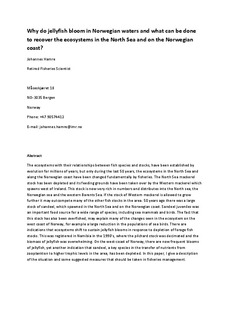| dc.description.abstract | The ecosystems with their relationships between fish species and stocks, have been established by evolution for millions of years, but only during the last 50 years, the ecosystems in the North Sea and along the Norwegian coast have been changed fundamentally by fisheries. The North Sea mackerel stock has been depleted and its feeding grounds have been taken over by the Western mackerel which spawns west of Ireland. This stock is now very rich in numbers and distributes into the North sea, the Norwegian sea and the western Barents Sea. If the stock of Western mackerel is allowed to grow further it may outcompete many of the other fish stocks in the area. 50 years ago there was a large stock of sandeel, which spawned in the North Sea and on the Norwegian coast. Sandeel juveniles was an important food source for a wide range of species, including sea mammals and birds. The fact that this stock has also been overfished, may explain many of the changes seen in the ecosystem on the west coast of Norway, for example a large reduction in the populations of sea birds. There are indications that ecosystems shift to sustain jellyfish blooms in response to depletion of forage fish stocks. This was registered in Namibia in the 1990’s, where the pilchard stock was decimated and the biomass of jellyfish was overwhelming. On the west-coast of Norway, there are now frequent blooms of jellyfish, yet another indication that sandeel, a key species in the transfer of nutrients from zooplankton to higher trophic levels in the area, has been depleted. In this paper, I give a description of the situation and some suggested measures that should be taken in fisheries management. | nb_NO |
